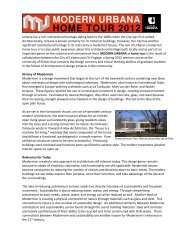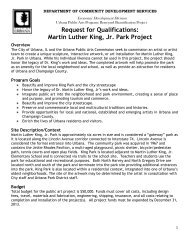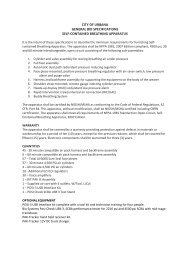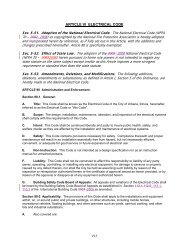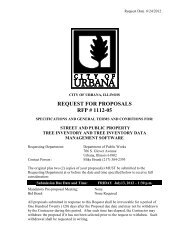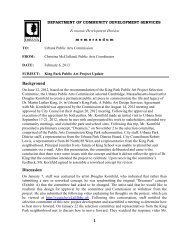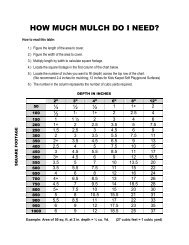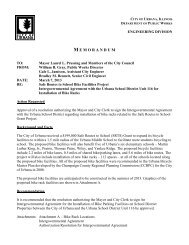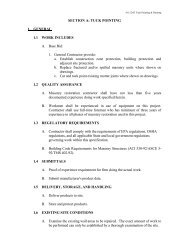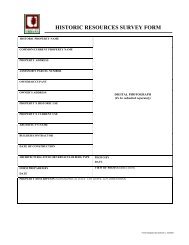CLIMATE ACTION PLAN - City of Urbana
CLIMATE ACTION PLAN - City of Urbana
CLIMATE ACTION PLAN - City of Urbana
- No tags were found...
You also want an ePaper? Increase the reach of your titles
YUMPU automatically turns print PDFs into web optimized ePapers that Google loves.
2.5<br />
URBANA’S ENERGY USE<br />
A. MONITORING ENERGY EFFICIENCY<br />
Monitoring progress towards becoming more energy efficient involves comparing community-wide building energy<br />
consumption data from year to year. However, some summers are hotter than others, and winter this year may be milder<br />
than the last year. Therefore, energy requirements associated with space heating and cooling respond to fluctuating<br />
weather conditions and a direct comparison <strong>of</strong> raw energy consumption data would be misleading as it does not<br />
accurately reflect whether the community is becoming more energy efficient.<br />
As a solution, we can compare annual energy use by plotting a graph <strong>of</strong> monthly energy use against monthly weather<br />
conditions. This is done by normalizing community-wide energy consumed per month against a ratio <strong>of</strong> the Heating<br />
Degree Days and Cooling Degree Days in that month.<br />
Heating Degree Days (HDD) is a measure used to estimate the amount <strong>of</strong> energy required for residential space<br />
heating during the cold season. Similarly, Cooling Degree Days (CDD) is a measure used to estimate the amount <strong>of</strong> air<br />
conditioning usage during the warm season. To calculate HDD and CDD, 65 o F is assumed to be a comfortable indoor<br />
temperature. The mean temperature for the day is calculated by taking the high and low temperature for the day,<br />
adding them together and dividing them by two. If the mean temperature is at or above 65 o F, then HDD is zero, that<br />
is, no energy was needed to heat indoor space. If the mean temperature is below 65 o F, the HDD equals 65 minus the<br />
mean temperature. For example, if the mean temperature was 55 o F, then HDD amount equals 10. Similarly if the mean<br />
temperature was at or below 65 o F, then the CDD is zero, that is no energy was needed to cool indoor space. If the mean<br />
temperature was 75 o F, then the CDD amount equals 65 minus the mean temperature, amounting to 10. A monthly HDD<br />
value and CDD value is reported by the Illinois State Climatologist for their weather station in <strong>Urbana</strong>.<br />
By plotting energy consumed against a ratio <strong>of</strong> HDD and CDD, we can arrive at yearly trends that account for variations<br />
in external weather conditions. This allows us to reach a more accurate yearly comparison <strong>of</strong> energy efficiency <strong>of</strong> the<br />
building stock after eliminating those consumption changes that are a response to variable external weather conditions.<br />
B. WEATHERIZATION<br />
In October 2009, the <strong>City</strong> <strong>of</strong> <strong>Urbana</strong> received an Energy Efficiency and Conservation Block Grant (EECBG) to be used<br />
toward reducing its carbon footprint. A part <strong>of</strong> this grant ($72,000) was used to create an innovative program in<br />
partnership with Ameren Illinois’ Act On Energy Program. Through this program residents were able to benefit from free<br />
residential energy audits and discounts on major envelope improvements. Under this program, residents <strong>of</strong> <strong>Urbana</strong><br />
were provided with a free energy analysis <strong>of</strong> their residence and a compensation <strong>of</strong> an additional 40 percent <strong>of</strong> the Act<br />
On Energy Incentive available for Ameren customers for undertaking housing shell improvements, namely air sealing,<br />
attic insulation and wall insulation. Between 2010 and February 2012, 826 <strong>Urbana</strong> homes were audited, and 169 homes<br />
were retr<strong>of</strong>itted. Strategies to further reduce residential sector building energy consumption rely on securing additional<br />
funding to continue the community weatherization program.<br />
The Champaign County Regional Planning Commission Community Services Department also <strong>of</strong>fers a Illinois Home<br />
Weatherization Assistance Program (IHWAP) which is designed to reduce energy costs and improve home comfort levels<br />
for low income residents. IHWAP is funded by the U.S. Department <strong>of</strong> Energy (DOE), the U.S. Department <strong>of</strong> Health and<br />
Human Services (HHS), and the state supplemental Energy Assistance Fund. Between January and May 2012, a total <strong>of</strong><br />
982 units were assisted through this program countywide, including 177 multi-family units in <strong>Urbana</strong>.<br />
<strong>City</strong> <strong>of</strong> <strong>Urbana</strong><br />
44



